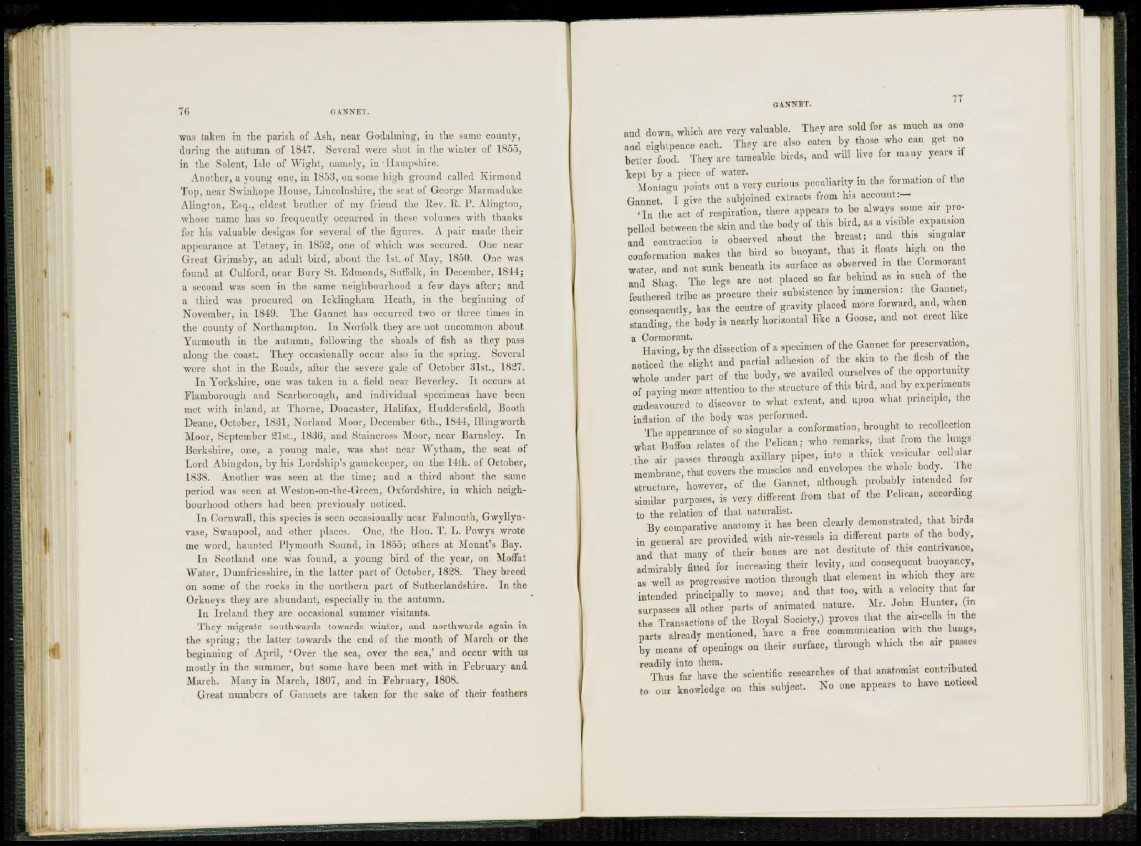
76 GANNET.
was taken in trio parish of Ash, near Godalming, in the same county,
during tin* autumn of 18-17. Several were shot in the winter of 1855,
in the Solent, Isle of Wight, namely, in Hampshire.
Another, a young one, in 1858, on some high ground called Kirmond
Top, near Swinhope House, Lincolnshire, the scat of George Mannaduke
Alington, Esq., eldest brother of my friend the Rev. It. P. Aliugton,
whose name has so frequently occurred in these volumes with thanks
for his valuable designs for several of the figures. A pair made their
appearance at Tetney, in 1852, one of which was secured. One near
Great Grimsby, an adult bird, about the 1st. of May, 1850. One was
found at Culford, near Bury St. Edmonds, Suffolk, in December. 1844;
a second was seen in the same neighbourhood a few days after; and
a third was procured on Icklingham Heath, in the beginning of
November, in 1849. The Gannet has occurred two or three times in
the county of Northampton. In Norfolk they are not uncommon about
Yarmouth in the autumn, following the shoals of fish as they pass
along the coast. They occasionally occur also in the spring. Several
were shot in the Roads, after the severe gale of October 31st., 1N27.
In Yorkshire, one was taken in a field near Beverley. It. occurs at
Flaiuborough and Scarborough, and individual specimens have been
met with inland, at Thorne, Doncaster, Halifax, Huddersfield, Booth
Deane, October, 1831, Norland Moor, December 6th., 1844, lllingworth
Moor, September 21st., 1836, and Staincross Moor, near Barnsley. In
Berkshire, one, a young male, was shot near Wytham, the seat of
Lord Abingdon, by his Lordship's gamekeeper, on the 14th. of October,
1838. Another was seen at the time; and a third about the same
period was seen at Wcston-on-the-Green, Oxfordshire, in which neighbourhood
others had been previously noticed.
In Cornwall, this species is seen occasionally near Falmouth, Gwyllynvase,
Swanpool, and other places. One, the Hon. T. L. I'owys wrote
me word, haunted Plymouth Sound, in 1855; others at Mount's Bay.
In Scotland one was found, a young bird of the year, on Moffat
Water, Dumfriesshire, in the latter part of October, 1828. They breed
on some of the rocks in the northern part of Sutherlandshire. In the
Orkneys they are abundant, esj^ecially in the autumn.
I n Ireland they are occasional summer visitants.
They migrate southwards towards winter, and northwards again in
the spring; the latter towards the end of the month of March or the
beginning of April, 'Over the sea, over the sea,' and occur with us
mostly in the summer, but some have been met with in February and
March. Many in March, 1807, and in February, 1808.
Great numbers of Ganuets are taken for the sake of their feathers
and down, which are very valuable. They are sold for as much as one
and cighipence each. They arc also eaten by those who can get no
better food. They are tameable birds, and will live for many years if
kept by a piece of water.
Montagu poiuts out a very curious peculiarity in the formation of the
Gannet. I give the subjoined extracts from his account:—
' I n the act of respiration, there appears to be always some air propelled
between the skin and the body of this bird, as a visible expansion
and contraction is observed about the breast; and this singular
conformation makes the bird so buoyant, that it floats high on the
water, and not sunk beneath its surface as observed in the ('ormorant
and Shag. The legs are not placed so far behind as in such of the
feathered tribe as procure their subsistence by immersion: the Gannet,
consequently, has the centre of gravity placed more forward, and, when
standing, the body is nearly horizontal like a Goose, and not erect like
a Cormorant.
Having, by the dissection of a specimen of the Gannet for preservation,
noticed the slight and partial adhesion of the skin to the flesh of the
whole under part of the body, we availed ourselves of the opportunity
of paying more attention to the structure of this bird, and by experiments
endeavoured to discover to what extent, and upon what principle, the
inflation of the body was performed.
The appearance of so singular a conformation, brought to recollection
what Buffon relates of the I'elican; who remarks, that from the lungs
the air passes through axillary pipes, into a thick vesicular cellular
membrane, that covers the muscles and envelopes the whole body. The
structure, however, of the Gannet, although probably intended for
similar purposes, is very different from that of the Pelican, according
to the relation of that naturalist.
By comparative anatomy it has been clearly demonstrated, that birds
in general are provided with air-vessels in different parts of the body,
and that many of their bones are not destitute of this contrivance,
admirably fitted for increasing their levity, and consequent buoyancy,
as well as progressive motion through that clement in which they are
intended principally to move; and that too, with a velocity that far
surpasses all other parts of animated nature. Mr. John Hunter, (in
the Transactions of the Koyal Society,) proves that the air-cells in the
parts already mentioned, have a free communication with the lungs,
by means of openings on their surface, through which the air passes
readily into them.
Thus far have the scientific researches of that anatomist contributed
to our knowledge on this subject. No one appears to have noticed